In This Article
Need a breathtaking getaway full of history and dramatic views? Head to Ronda! Perched atop a deep gorge in Spain’s Andalusia region, Ronda offers stunning scenery, historic charm, and authentic Spanish culture. Whether you're looking for romantic vistas, rich history, or delicious tapas, Ronda is a must-visit destination.
When I like to visit
The best time to visit Ronda is during spring or fall (April–June and September–October). Mild temperatures and smaller crowds make these seasons ideal for walking tours, sightseeing, and outdoor dining. Summers can be very hot, while winter is cooler but still pleasant for travel.
Tips for getting There
- If you are traveling by car: Ronda is about 1.5 hours from Málaga and about 2 hours from Seville, making it a popular stop on Andalusian road trips.
- By Train: Direct trains from Málaga, Cordoba, and Madrid connect to Ronda’s picturesque train station, offering an easy and scenic journey.
- By Bus: Regular bus services operate between Ronda and major cities like Málaga, Marbella, and Seville.
Where I like to stay
- Parador de Ronda – Stay in a former town hall right next to the famous Puente Nuevo bridge with stunning cliffside views.
- Hotel Catalonia Reina Victoria – Beautifully restored historic hotel offering panoramic terrace views and an elegant spa.
- Hotel Montelirio – Cozy boutique hotel with dramatic views over the gorge and charming Andalusian design.
Best Things to Do
1. Marvel at Dramatic Views and History from Puente Nuevo
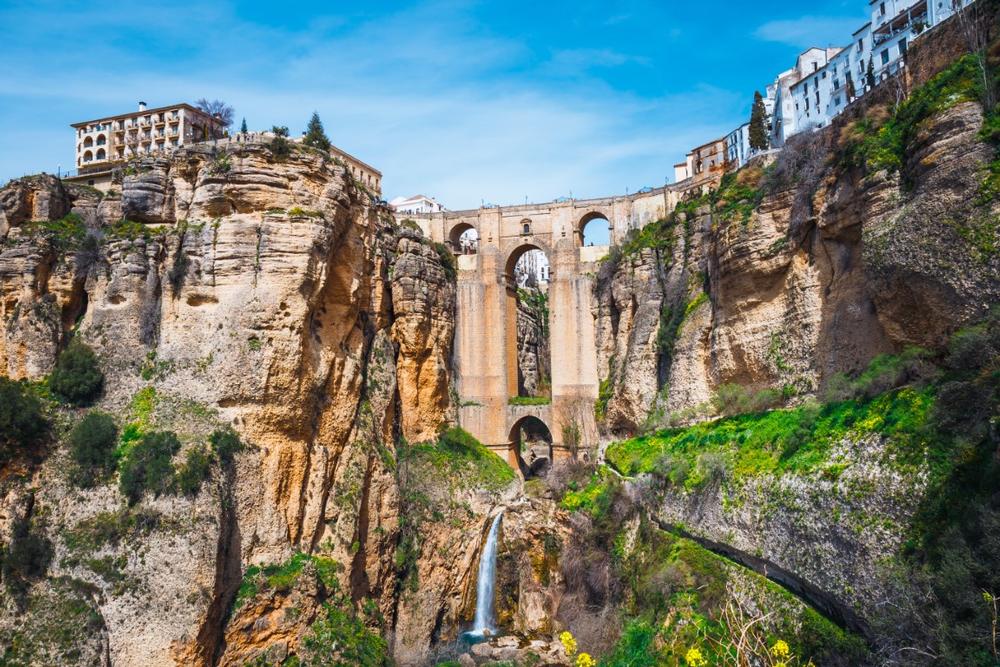
© dziewul/stock.adobe.com
The Puente Nuevo (New Bridge) is an 18th-century bridge that rises from the floor of the El Tajo Gorge to over 400 feet and connects the old Moorish town and the newer parts of the city, including El Mercadillo (The Little Market). Built in 1759, the bridge took 42 years to complete and cost the lives of 50 workers during construction. A small stone-walled cavern in the middle of the bridge above the main arch was once used a prison during Spain’s Civil War and now houses an exhibition about the history and the construction of the bridge. There are several viewpoints along the bridge that offer spectacular panoramic vistas of the gorge.
Calle Real, 2, 29400 Ronda, Málaga, Spain
2. Step Back in Time Crossing the Ancient Puente Viejo
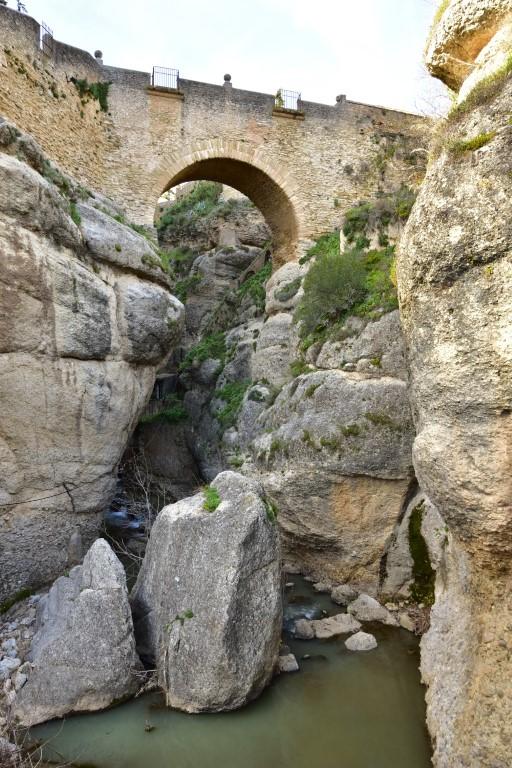
© Barbara/stock.adobe.com
Built in the 16th century, Puente Viejo is the oldest and smallest of three bridges that span the 400-foot-deep El Tajo Gorge. Thought to have been built on the remnants of an earlier bridge, Puente Viejo was the only connection between Mercadillo and La Ciudad until Puente Nuevo was built years later. The gate above the bridge known as the Arco de Felipe V was the only entrance to La Ciudad during this time, making it a key defensive position. Today, the bridge currently only carries pedestrian traffic.
Calle Real, 2, 29400 Ronda, Málaga, Spain
What to do if you are traveling with kids:
3. Stroll Scenic Clifftop Paths at Alameda del Tajo

© Pedro/stock.adobe.com
The Alameda del Tajo is a beautiful green park in the heart of Ronda that connects the famous Plaza de Toros with the edge of the El Tajo Gorge. The park has a central tree-lined boulevard which is surrounded by flowering gardens, pergolas woven with roses, and a beautiful Himalayan cedar, and at the Mirador de Ronda, panoramic balconies boast heart-stopping vistas over the valley and the Sierra de Grazalema mountains. The park is popular with both locals and tourists wanting a lovely spot in which to relax.
1 Paseo Blas Infante, Ronda, Spain
4. Wander Terraced Gardens with Stunning Gorge Views at Jardines de Cuenca
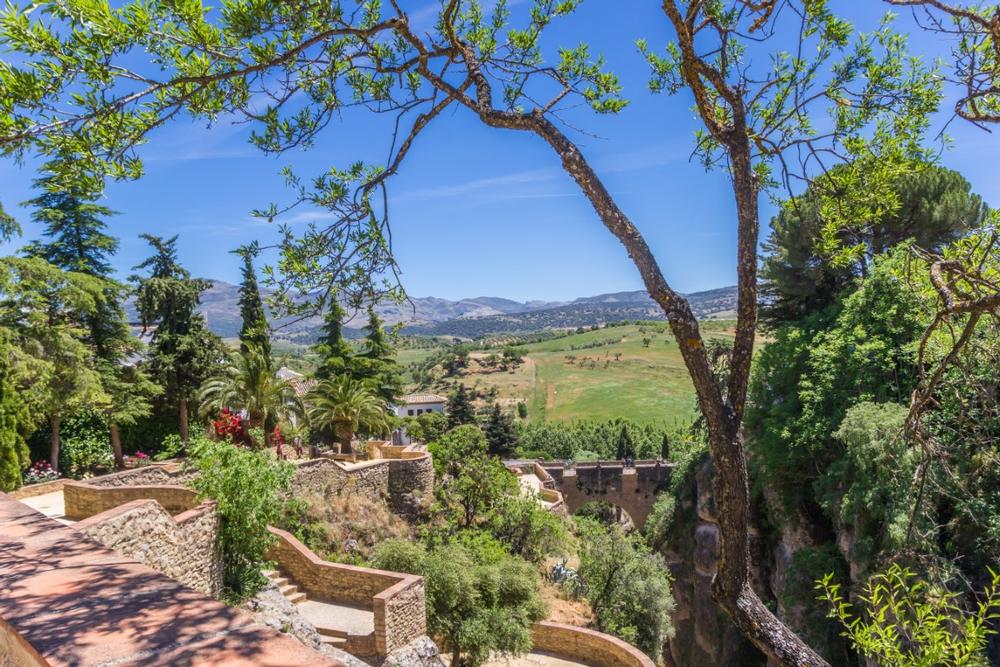
© venemama/stock.adobe.com
The Jardines de Cuenca - Cuenca Gardens is a beautiful public garden that winds from the Puente Viejo to the top of El Mercadillo (Little Market) or New Town. Built in 1975, the garden is named after Ronda’s sister city and is comprised of several walled terraces filled with palm trees, flower beds, cypress trees, evergreen trees, and succulents. Each terrace and a new level of the gardens boasts spectacular views of the El Tajo Gorge, the long valley, and the Río Guadalevín, as well as some of the city’s most famous landmarks like the Casa del Rey Moro and Puente Nuevo.
Calle Escolleras, 1, 29400 Ronda, Málaga, Spain
5. If You’re Fascinated by Bullfighting History, Visit Plaza de Toros de Ronda
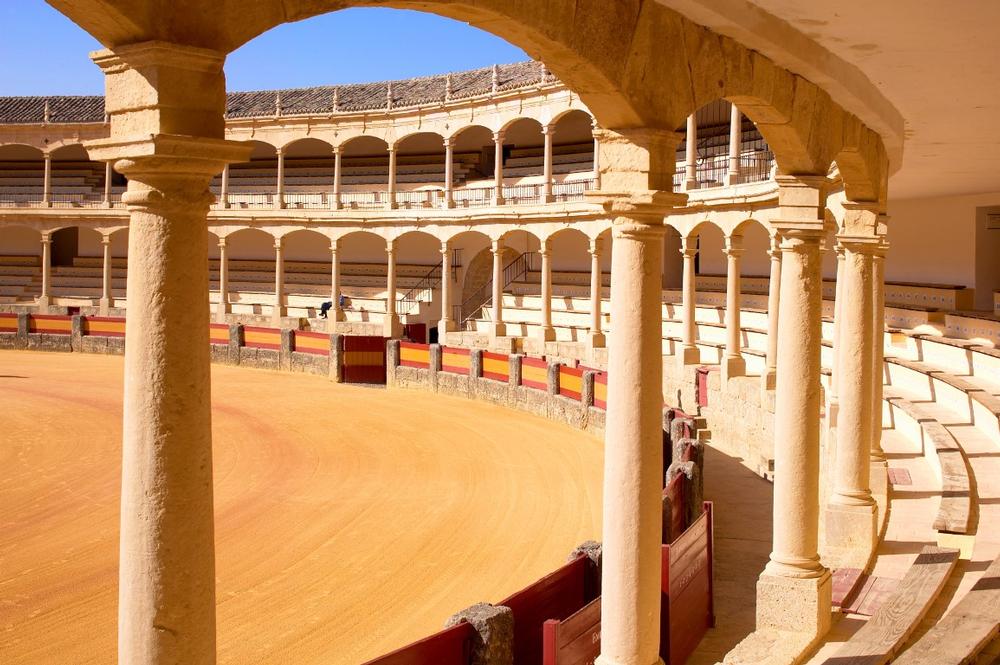
© Günter Menzl/stock.adobe.com
The Plaza de Toros de Ronda is an ancient bullring in Ronda that was built in 1785 by architect Jose Martin Aldehuela, who also built the Puente Nuevo. The 5,000-seat bullring has a 217-foot diameter, is surrounded by a passage formed by two rings of stone, and has 136 pillars that form 68 arches. The stately bullring was once used regularly for bullfights and was the home of the Ronda School for Bullfighting, founded by one of Spain’s greatest bullfighters, Pedro Romero. Today, the bullring hosts just one bullfight a year for town’s September Feria and has a museum with guided tours.
Plaza de Toros de Ronda, 15 Calle Virgen de la Paz, Ronda, Spain, Phone: +34-952-87-41-32
Activities and Attractions for Couples:
6. Relax and Reflect in the Ancient Arab Baths of Ronda
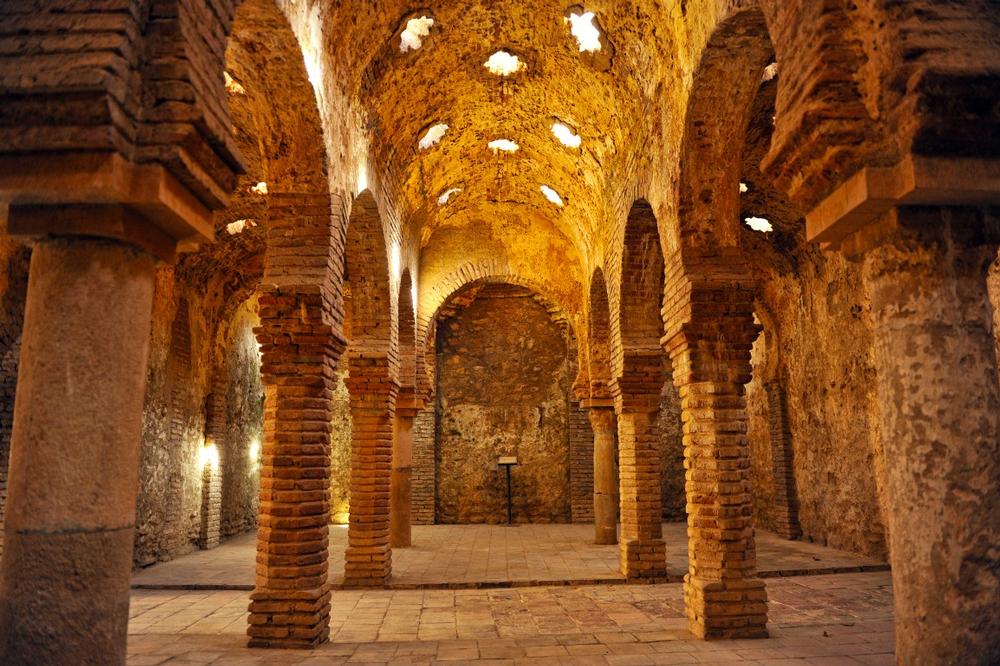
© joserpizarro/stock.adobe.com
The Baños Arabes (Arab Baths) is located in the old Arab quarter of the city, known as the San Miguel Quarter, and are among the best-preserved in Spain. Built in the 10th and 11th century during the reign of King Abomelik, the baths are a reflection of the town’s Moorish heritage with star-shaped roof vents for light and ventilation inspired by the Alhambra of Granada. The intricate hydraulic system drew water from the Las Culebreas stream to the complex and is still largely intact today, as well as the large cauldron used to heat the water.
Baños Arabes, 11 Calle Molino de Alarcón, Ronda, Spain, Phone: +34-952-18-71-19
7. Explore Secret Stairways and Legends at the Palace of the Moorish King

© arenaphotouk/stock.adobe.com
Palacio del Rey Moro y La Mina (Palace of the Moorish King and the Water Mine) was built in the 18th century but was never the home of the Moorish King. The palace was completely remodeled by the Duchess of Parcent in 1920 and features beautifully manicured gardens designed by French architect Jean Claude Forestier. The property is home to the Water Mine, a 14th-century relic of Ronda's Moorish occupation built by King Abomelik who used Christian captives as slave labor to cut steps into the stone walls of the gorge to bring water up from the Río Guadelevin with water skins. Originally there were 365 steps, and after restoration in 1911, there are now 300 steps that pass through several chambers, including the Sala de Secretos - Room of Secrets.
Casa del Rey Moro, 9 Calle Cuesta de Santo Domingo, Ronda, Spain, Phone: +34-952-18-71-19
8. If You Crave Hiking, Caves, and Scenic Villages, Head to Sierra de Grazalema Natural Park

© akturer/stock.adobe.com
Parque Natural de la Sierra de Grazalema (Sierra de Grazalema Natural Park) is a natural park in the north-eastern part of the province of Cádiz that encompasses 51,695 hectares, including a complex of mountain ranges known the Sierra de Grazalema which are part of the Cordillera Subbética. The biosphere reserve is home to several interesting features, including a karstic region with large limestone caverns, towering mountain peaks including the 5,426-foot peak of Pinar (Torreón), and large colonies of vultures, including a few pairs of Egyptian vultures.
Calle Empedrada, 54, 11610 Grazalema, Cádiz, Spain, Phone: +34-956-70-97-33
Must-see if you are a first-time visitor:
- Wander through the Old Town (La Ciudad) – Discover cobblestone streets, historic churches, and Moorish architecture.
- Hike or drive to the bottom of El Tajo Gorge – Capture incredible views of Ronda from below and enjoy the surrounding nature trails.
Where I Like to Eat
- Tragatá – Trendy tapas bar serving creative small plates and Spanish classics with a modern twist.
- Restaurante Bardal – Michelin-starred dining experience featuring contemporary Andalusian cuisine.
- Casa María – Cozy local favorite with a market-fresh menu that changes daily, focusing on authentic Spanish flavors.
My favorite local events:
- Ronda Romántica (May) – Annual celebration with parades, costumes, and festivities recreating 19th-century life in Ronda.
- Corrida Goyesca (September) – Historic bullfight event where participants dress in traditional 18th-century attire, part of the Feria de Pedro Romero.
- Semana Santa (March/April) – Traditional Holy Week processions with stunning floats and ceremonies throughout the town.
My favorite day trips within 30 Minutes to 1 Hour of Ronda, Spain:
- Setenil de las Bodegas (20–30 min) – Explore a fascinating village built into cliffs with houses tucked under massive rock overhangs.
- Zahara de la Sierra (45 min) – Visit a picturesque whitewashed hilltop town with a beautiful reservoir and historic castle.
- Grazalema (30–40 min) – Hike in the stunning Sierra de Grazalema Natural Park, known for its rugged beauty and lush forests.
- El Caminito del Rey (1 hour) – Experience an exhilarating cliffside walkway and breathtaking canyon views near Ardales.
- Júzcar (45 min) – Wander through Spain’s famous “Smurf Village,” where all the buildings are painted bright blue.
Plan Your Trip










